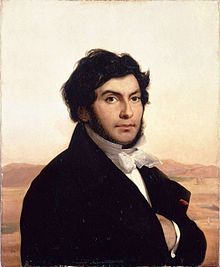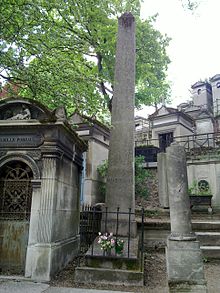- Jean-François Champollion
-
Jean-François Champollion 
Jean-François Champollion, by Léon CognietBorn 23 December 1790
Figeac, LotDied 4 March 1832 (aged 41)
ParisNationality French Fields Egyptian hieroglyphs Known for Rosetta Stone Jean-François Champollion (23 December 1790 – 4 March 1832) was a French classical scholar, philologist and orientalist, decipherer of the Egyptian hieroglyphs.
Champollion published the first translation of the Rosetta Stone hieroglyphs in 1822, showing that the Egyptian writing system was a combination of phonetic and ideographic signs.
Contents
Biography
Champollion was born in Figeac, Lot, the last of seven children (two of whom had already died before he was born). He was raised in humble circumstances; because his parents could not afford to send him to school, and he was taught to read by his brother Jacques. Jacques, although studious and largely self-educated, did not have Jean-François' genius for language; however, he was talented at earning a living, and supported Jean-François for most of his life.[1]
He lived with his brother in Grenoble for several years, and even as a child showed an extraordinary linguistic talent. By the age of 16 he had mastered a dozen languages and had read a paper before the Grenoble Academy concerning the Coptic language. By 20 he could also speak Latin, Greek, Hebrew, Amharic, Sanskrit, Avestan, Pahlavi, Arabic, Syriac, Chaldean, Persian and Ge'ez in addition to his native French.[2] In 1809, he became assistant-professor of History at Grenoble University. His interest in oriental languages, especially Coptic, led to his being entrusted with the task of deciphering the writing on the then recently-discovered Rosetta Stone, and he spent the years 1822–1824 on this task. His 1824 work Précis du système hiéroglyphique gave birth to the entire field of modern Egyptology. He also identified the importance of the Turin King List, and dated the Dendera zodiac to the Roman period. His interest in Egyptology was originally inspired by Napoleon's Egyptian Campaigns 1798–1801. Champollion was subsequently made Professor of Egyptology at the Collège de France.[3]
Egyptian hieroglyphs
Thomas Young was one of the first to attempt decipherment of the Egyptian hieroglyphs, basing his own work on the investigations of Swedish diplomat Åkerblad, though he failed to fully decipher the script, Young was able to translate some of the stone leading the way for Champollion to begin his own investigations.
In 1822, Champollion finally published the first correct translation of the hieroglyphs and the key to the grammatical system. Young and all others praised this work.
Franco-Tuscan Expedition
In 1827 Ippolito Rosellini, considered the founder of Egyptology in Italy, went to Paris for a year in order to improve his knowledge of the method of decipherment proposed by Champollion. The two philologists decided to organize an expedition to Egypt to confirm the validity of the discovery. Headed by Champollion and assisted by Rosellini his first disciple and great friend, the mission was known as the Franco-Tuscan Expedition, and was made possible by the support of the grand-duke of Tuscany, Leopold II, and the King of France, Charles X.
On the 21st of July 1828, with four members, they boarded the ship Eglé at Toulon and set sail for Egypt. They travelled upstream along the Nile and studied an exhaustive number of monuments and inscriptions. The expedition led to a posthumously-published extensive Monuments de l'Égypte et de la Nubie (1845). Unfortunately, Champollion's expedition was blemished by unchecked looting. Most notably, while studying the Valley of the Kings, he damaged KV17, the tomb of Seti I, by removing a wall pannel of 2.26 x 1.05 m in a corridor while other elements were removed by his companion Rossellini or the German expedition of 1845. The scenes are now in the collections of the Louvre, the museums of Florence and Berlin. During his stay, the Khedive of Egypt, Muhammad Ali Pasha, offered the two obelisks standing at the entrance of Luxor Temple to France in 1829, but only one was transported to Paris where it now stands on the Place de la Concorde.
Exhausted by his labours during and after his scientific expedition to Egypt, Champollion died of an apoplectic attack in Paris in 1832 at the age of 41. He is buried in the Père Lachaise cemetery.
Certain portions of Champollion's works were edited by his elder brother, Jacques Joseph Champollion-Figeac; Jacques Joseph's son, Aimé-Louis (1812–1894), wrote a biography of the two brothers.
In popular culture
Champollion was portrayed by Elliot Cowan in the 2005 BBC docudrama Egypt.
Works
- Le Normant, ed (1819). Annales des Lagides, ou chronologie des rois grecs d'Égypte successeurs d'Alexandre le Grand. ;
- Lettre à M. Dacier relative à l'alphabet des hiéroglyphes phonétiques. 1822. ;
- Panthéon égyptien, collection des personnages mythologiques de l'ancienne Égypte, d'après les monuments (explanatory text to illustrations by Léon-Jean-Joseph Dubois ). 1823. http://gallica.bnf.fr/notice?N=FRBNF30219351.
- Précis du système hiéroglyphique des anciens Égyptiens. 1824. ;
- Lettres à M. le Duc de Blacas d'Aulps. 1826. ;
- Notice descriptive des monuments égyptiens du musée Charles X. 1827. ;
- Précis du système hiéroglyphique des anciens Égyptiens ou Recherches sur les éléments premiers de cette écriture sacrée, sur leurs diverses combinaisons, et sur les rapports de ce système avec les autres méthodes graphiques égyptiennes. 1828. ;
- Lettres écrites d'Égypte et de Nubie. 1828–1829. http://www.gutenberg.org/etext/10764. ;
- Grammaire égyptienne. 1836, posthumously. ;
- Dictionnaire égyptien en écriture hiéroglyphique. 1841, posthumously. http://gallica.bnf.fr/notice?N=FRBNF33988260. ;
- Others – Principes généraux de l'écriture sacrée, new edition with a preface by Christiane Ziegler, Institut d'Orient, 1984.
Musées Champollion
- A museum devoted to Jean-François Champollion was created in his birthplace at Figeac in Lot. It was inaugurated 19 December 1986 in the presence of President François Mitterrand and Jean Leclant, secrétaire perpétuel of the Académie des inscriptions et belles-lettres. After two years of building work and extension, the museum re-opened in 2007. Besides Champollion's life and discoveries, the museum also recounts the history of writing. The whole façade is covered in pictograms, from the original ideograms of the whole world.
- The "*Maison Champollion" at Vif in Isère, formerly the property of Jean-François's brother.
Notes
Further reading
- Allen, Don Cameron (1960). "The Predecessors of Champollion". Proceedings of the American Philosophical Society 104 (5): 527–547.
- Adkins, Lesley; Adkins, Roy (2000). The Keys of Egypt: The Obsession to Decipher Egyptian Hieroglyphs. HarperCollins Publishers. ISBN 0060194391.
- Meyerson, Daniel (2005). The Linguist and the Emperor: Napoleon and Champollion's Quest to Decipher the Rosetta Stone. Random House Trade. ISBN 0345448723.
External links
Categories:- Collège de France faculty
- French Egyptologists
- French archaeologists
- French philologists
- Epigraphers
- Burials at Père Lachaise Cemetery
- 1790 births
- 1832 deaths
- People from Lot
- Hellenic epigraphers
- Knights of the Order of Saint Joseph
- Members of the Académie des Inscriptions et Belles-Lettres
Wikimedia Foundation. 2010.

